Effective Techniques to Remove Chocolate Stains
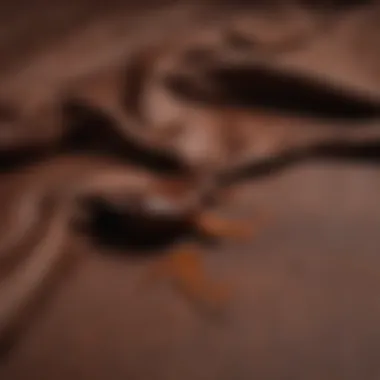
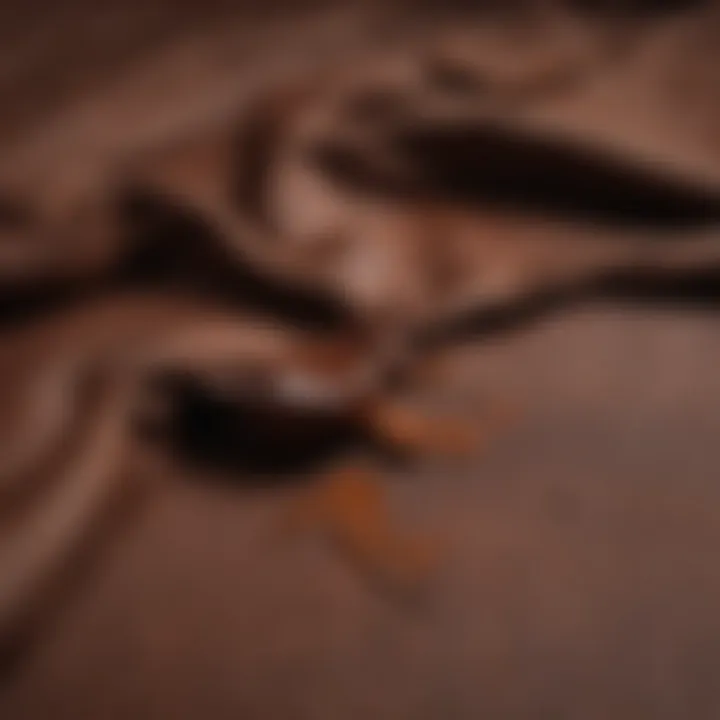
Intro
Chocolate stains pose a significant challenge for homeowners and cloth enthusiasts alike. When these rich, dark stains seep into fabrics, they can often seem irreparable. This article aims to provide effective techniques to help you tackle chocolate stains promptly and efficiently. By understanding the nature of chocolate and employing specific methods, anyone can effectively salvage their clothing.
First, we recognize the immediate importance of addressing chocolate stains. The longer the stain sits on the fabric, the more difficult it becomes to remove. Therefore, quick action can make a considerable difference in the outcome. We will detail practical steps for different fabric types, ensuring that the right approach is taken based on the material involved.
Overall, this guide is tailored for homeowners and design enthusiasts, empowering them with the knowledge to maintain their clothing and approach stains with confidence.
Design Inspiration
While chocolate stains may not seem related to design, the choices of fabrics in your wardrobe can greatly impact your cleaning routines. Understanding fabric types and their characteristics is essential.
Trending Styles
In current trends, light fabrics like cotton and linen are popular. However, these materials can easily absorb stains, including chocolate. Darker color choices may hide stains better but may still need attention. For home decor enthusiasts, considering stain-resistant fabrics can also be a wise choice for upholstery, particularly in high-use areas.
Color Palettes
When selecting clothing, choosing colors that can mask potential stains is an informed choice. Neutral tones may blend in better with small stains while allowing vibrancy in the fabric. However, if vibrant colors are preferred, be ready with effective cleaning methods for those inevitable chocolate encounters.
Practical Tips
To ensure your clothing remains in pristine condition, following practical maintenance and care methods is essential.
Maintenance & Care
- Prompt action: Always treat a stain as soon as possible. Blot with a clean, dry cloth to absorb excess chocolate without pressing it further into the fabric.
- Cold water rinse: Rinse under cold water before applying any treatment to help release the chocolate from the fibers. Hot water may set the stain, making it more challenging to remove.
- Stain removers: Use a dedicated stain remover suitable for the fabric. Always test it on a small, inconspicuous area first.
Budgeting & Planning
Cleansing supplies can be costly. It is beneficial to budget and plan for ongoing maintenance:
- Consider investing in a few universal stain removal products, which can save you money over time.
- Stock your cleaning arsenal with the essentials like dish soap, vinegar, and baking soda. These products can handle various stains, making them valuable.
"Timely intervention is the key to successfully minimizing chocolate stains on clothing."
Recognizing the right techniques, maintaining proper fabric care, and planning for future needs can make a significant impact in a household. With these insights, you're now better prepared to tackle chocolate stains effectively.
Understanding Chocolate Stains
Chocolate stains are a common nuisance that many face in their everyday lives. Understanding these stains is significant for effective removal strategies. Knowledge about the stain's nature, composition, and the challenges they present can guide homeowners in tackling them efficiently. Knowing what you are dealing with is the first step towards finding the appropriate removal technique. This section covers the essential elements that constitute chocolate stains and why they can be particularly stubborn.
Composition of Chocolate
Chocolate consists of various ingredients that contribute to its formulation and, subsequently, its staining properties. The primary components are cocoa solids, cocoa butter, sugar, and sometimes milk. Each of these elements plays a role in how chocolate interacts with fabrics.
- Cocoa solids: These are responsible for the deep color of chocolate and can leave behind intense dark stains if not addressed quickly.
- Cocoa butter: This fatty component can seep into fibers, making the stain particularly oily and hard to remove.
- Sugar: While sugar may contribute less to the initial appearance of a stain, it can draw in dirt and debris, creating a more complex stain over time.
- Milk: In milk chocolates, dairy proteins can bind with fabric fibers, complicating removal.
Each of these components results in a unique stain that may require different approaches to remove effectively.
Why Chocolate Stains Are Challenging
Chocolate stains can be tricky due to their oily and pigmented nature. The following points highlight why they pose such a challenge:
- Immediate action requirement: The longer a chocolate stain sits, the more time it has to set, making it increasingly difficult to remove.
- Fatty components: The presence of cocoa butter and other fats necessitates the use of specific cleaning agents that can break down oils, which are not always used in standard laundry routines.
- Color intensity: Dark chocolates can create a vivid stain that may persist despite washing, especially on lighter fabrics.
- Fabrics' response: Different fabrics react variably to chocolate; some may absorb the stain deeply, while others may release it with minimal effort. Understanding the specific fabric type is crucial for effective stain treatment.
In summary, having an in-depth knowledge about the composition of chocolate and the unique challenges its stains present is vital. Proper understanding allows for the selection of the right techniques, maximizing the chances of successful stain removal.
This foundational knowledge sets the stage for practical actions homeowners can take when faced with chocolate stains, ensuring that they are well-prepared to tackle the situation when it arises.
Immediate Actions to Take
When faced with a chocolate stain on clothing, the initial response is critical. Immediate actions can significantly affect the stain's permanence. Prompt attention not only minimizes the chances of a stubborn mark setting in but also ensures that the cleaning process is more effective. This section will cover two key elements: assessing the stain and removing excess chocolate.
Assessing the Stain


Before any cleaning method can be applied, it is essential to first assess the stain. Understanding its nature can offer insights into how best to tackle it. Check the size, depth, and fabric type affected by the chocolate. Knowing whether the clothing is cotton, silk, or synthetic influences your cleaning technique.
Additionally, evaluate how long the stain has been on the fabric. The longer the chocolate sits, the more difficult it becomes to remove. Take a moment to determine if the stain is still fresh or has begun to dry. Fresh stains respond better to cold water and gentle blotting, whereas dried stains may need more aggressive treatment.
"Timely and informed responses to stains can save your garment."
Removing Excess Chocolate
Once you've assessed the stain, the next step is to remove excess chocolate. Begin by gently scraping any solid chocolate from the fabric. Use a dull knife or spoon for this task to prevent further embedding the chocolate into the fibers. Be cautious not to rub, as this might cause the stain to spread.
After scraping, it is important to blot the area with a clean cloth or paper towel. This action helps in lifting away any remaining chocolate embedded in the fabric. Always blot from the outside of the stain towards the center to prevent spreading. Repeating this step may demonstrate improvement in the stain’s appearance.
Ensure the cloth or paper towel used is clean. If you use a dirty cloth, you risk transferring more dirt onto the garment. Completion of these steps allows for a smoother transition to the next stages of cleaning, ensuring that the stain removal process is as efficient as possible.
Preparation Before Cleaning
Before you dive into the task of removing chocolate stains, preparation is key. Taking the proper steps ensures a more effective cleaning process. Knowing how to prepare can significantly influence your success in stain removal.
Understanding your cleaning approach involves two main elements: gathering necessary supplies and testing fabric sensitivity. These factors can enhance the efficiency of the techniques you will use. By preparing adequately, you can avoid damaging your fabric, which is essential for maintaining the longevity of clothing.
Gathering Necessary Supplies
Before attempting to address chocolate stains, it is important to collect the relevant supplies. The right tools can make a significant difference. Here’s a list of items you may need:
- Cold water: Essential for rinsing and preventing the stain from setting.
- Dish soap: Effective for breaking down fats that might be present in chocolate.
- Stain remover: A specialized product can provide more rigorous cleaning.
- White cloths or paper towels: Use these to blot the stain without spreading it.
- Spoon or blunt knife: For removing excess chocolate before cleaning.
Gathering everything beforehand prevents interruptions while cleaning. You want to act quickly, as fresh stains are easier to treat. Prepare your cleaning area to make the process as smooth as possible.
Testing Fabric Sensitivity
Every fabric has its unique characteristics, and being aware of these can prevent potential damage. Therefore, testing fabric sensitivity is a crucial step in preparation.
To test sensitivity, follow these steps:
- Choose an inconspicuous area: This could be inside a seam or hem.
- Apply a small amount of the cleaning solution: Whether that is diluted dish soap or stain remover.
- Wait for a few minutes: Observe any changes in color or texture.
- Blot: Use a white cloth for this, ensuring that there is no transfer of color.
If there is no noticeable damage to the fabric, you can proceed with confidence. However, if signs of discoloration appear, consider using a gentler method or consult a professional. Careful testing ensures that your efforts to remove chocolate stains do not result in undesired outcomes.
Tip: Always refer to the care label on your garment for specific instructions on cleaning and fabric care, as this can vary greatly.
Preparation is not just a guideline; it is an essential phase in the process of removing chocolate stains. A well-prepared approach can lead to effective results, preserving the integrity of your clothing while enhancing your cleaning confidence.
Techniques for Different Fabrics
Understanding the specific fabric type is crucial when it comes to removing chocolate stains. Each fabric has its own unique properties, and these dictate the methods suitable for effective cleaning. Using the wrong technique can lead to permanent damage or set the stain further. Having knowledge about how different materials interact with chocolate and cleaning agents allows for more targeted and successful stain removal. Cotton, silk, and synthetic fabrics have distinct characteristics that warrant varied approaches to tackle chocolate stains effectively.
Removing Chocolate from Cotton
Cotton is a common fabric found in many households, known for its durability and comfort. Removing chocolate stains from cotton is usually straightforward due to its robust nature. Initially, it is advisable to scrape off any excess chocolate gently with a blunt knife or spoon.
Next, staining often needs cold water. Rinsing the fabric under cold water helps flush as much of the chocolate out as possible before treating it with soap. Dish soap can be applied directly to the stained area and agitated lightly with fingers or a soft brush. Allowing it to sit for about five to ten minutes helps the soap penetrate the stain. Afterward, rinsing again with cold water is beneficial.
Finally, laundering the cotton garment as usual, following the care label instructions, increases success in stain removal. If any traces remain, repeat the process because heat from drying can set unintended stains.
Removing Chocolate from Silk
Silk deserves special attention due to its delicate nature. When dealing with chocolate stains on silk, prompt action is essential. Begin by scraping away excess chocolate gently, ensuring not to damage the weave of the fabric. Next, use a clean cloth dampened with cold water to blot the stain instead of rubbing, which can spread it further. This gentle approach is critical.
To treat the stained area, it is advisable to prepare a mild cleaning solution. Mixing a few drops of gentle shampoo or mild detergent with cold water can work well. Apply this mixture to the stain using another clean cloth, continuing to blot carefully until the stain lifts. Rinse the area with a cloth dampened with cold water; be cautious not to oversaturate the silk.
In many cases, professional cleaning can be an option if the chocolate stain persists or if the silk piece is particularly valuable.
Removing Chocolate from Synthetic Fabrics
Synthetic fabrics like polyester and nylon are often more resilient compared to natural fibers, making chocolate stain removal potentially simpler. First, remove as much chocolate as possible without damaging the fabric, usually by scraping or gently blotting.
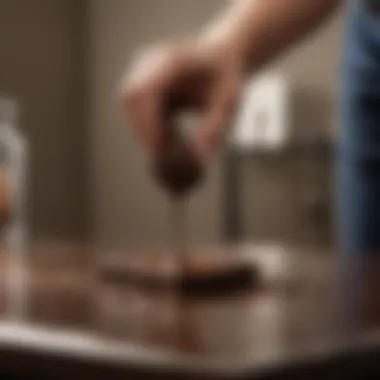
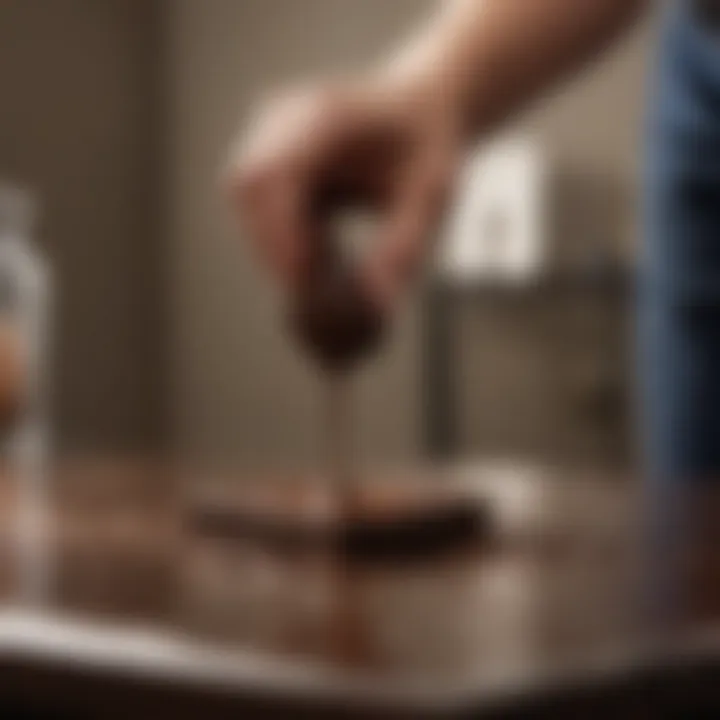
A key aspect of removing chocolate from synthetic fibers is using the right temperature of water. Warm water can enhance the effectiveness of certain detergents. Hence, rinsing the stained area with cool water before applying a stain remover is helpful. A combination of laundry detergent mixed with warm water can be applied to the stain. Allow it to sit for about ten minutes to penetrate the fabric.
After treating, washing the synthetic garment in a washing machine on the appropriate cycle can finalize the removal process. If chocolate remains, it is essential to avoid drying the fabric until the stain is completely gone, as heat can cause it to set.
By employing the right techniques based on the fabric type, successful chocolate stain removal becomes much more plausible, providing a cleaner and fresher appearance of your garments.
Cleaning Techniques: A Step-by-Step Guide
Effective cleaning techniques are crucial when dealing with chocolate stains. A systematic approach not only helps in removing the stain but also protects the fabric in the long run. Each step in this guide serves a specific purpose, reducing the likelihood of the stain setting in. The techniques outlined here are simple yet effective, making them suitable for a variety of fabrics. Notably, when implemented correctly, they can significantly enhance the chances of keeping your garments in prime condition.
Cold Water Rinse
Start the stain removal process with a cold water rinse. This method performs two key functions: it helps to lift the chocolate from the fabric and prevents the stain from setting. Cold water is less likely to harden the chocolate, making it easier to remove. To apply this technique, hold the stained area under cold running water for about 5 to 10 minutes. Ensure you rinse from the back of the stain to push the chocolate out rather than deeper into the fabric. This initial step is vital, as it preps the fabric for further cleaning methods.
Using Dish Soap
After the cold water rinse, the next logical step is to use dish soap. Liquid dish soap is particularly effective for breaking down the oils and fats in chocolate, making it easier to lift the stain. Apply a small amount directly onto the stained area, and gently work it into the fabric with your fingers. Leave it to sit for at least 5 minutes to allow the soap to bond with the chocolate residue. During this time, avoid rubbing too harshly, as this may damage delicate fabrics. After this period, rinse the fabric again with cold water to remove both the soap and the lifted chocolate.
Applying Stain Remover
If the stain persists despite using dish soap, applying a dedicated stain remover is advisable. Look for a stain remover that specifically claims efficacy against food stains. When using the stain remover, follow the instructions carefully, applying it directly to the affected area. Let it set as recommended, usually around 5 to 10 minutes. After waiting, rinse with cold water again. It is essential to treat the stain promptly for the best results. Keep in mind that this step should be used as a follow-up to the earlier methods, ensuring each step is completed in order for optimal stain removal.
"Act quickly and effectively when chocolate stains occur, as prompt action significantly impacts the cleaning process."
Incorporating these techniques increases the chances of effectively removing chocolate stains and preserving the quality of your clothing. By understanding and following this step-by-step guide, the process becomes less daunting, and stain removal transforms from a mere chore into a manageable task.
Dealing with Dried Chocolate Stains
Dried chocolate stains present a unique challenge for anyone trying to maintain their clothing. Unlike fresh stains, dried chocolate can set into the fabric, making removal more complex. Understanding how to effectively combat these stains is crucial for preserving the integrity of your garments. Prompt attention to fresh stains is ideal, but not all situations allow for immediate action. Learning about the right methods to handle dried chocolate can save your favorite outfit from becoming permanently marked.
Rehydrating the Stain
To remove dried chocolate stains, rehydrating the stain is a critical first step. This method involves softening the chocolate, making it easier to lift from the fabric. Use a clean cloth or sponge to dampen the stained area with cold water. It is important to saturate the stain gently without soaking through the fabric excessively. If you can, apply a few drops of liquid dish soap to the water to enhance its effectiveness at breaking down the oily components of the chocolate. Let it sit for about 10 minutes, allowing the fabric to absorb moisture. This careful approach can help to loosen the chocolate from the fibers without risking damage to the fabric.
Scraping and Blotting Techniques
Once the stain has been rehydrated, it is essential to proceed with scraping and blotting techniques. First, use a dull knife or a credit card to carefully scrape away the now softened chocolate. Be cautious not to press too hard as it might damage the fabric. Next, take a clean cloth or paper towel to blot the area gently. You should focus on lifting the chocolate rather than rubbing, which may spread the stain or push it deeper into the material. Repeat this process as necessary, changing the cloth or towel frequently to avoid redistributing the stain.
Remember, persistence is key. If the stain does not come out on first attempts, do not be discouraged. A combination of proper hydration and gentle removal often yields great results.
By approaching dried chocolate stains with the right techniques, you increase your chances of effectively restoring your clothing to its original state. Each step plays a significant role in your overall success.
Aftercare for Treated Clothes
Aftercare is a crucial phase in the process of removing chocolate stains from clothing. It’s not merely about eradicating the immediate stain; it extends to ensuring the fabric maintains its integrity and remains visually appealing. Proper aftercare can prevent residual marks, degradation of fabric quality, and enhance the longevity of garments. Thus, understanding this aspect is essential for any homeowner or fashion enthusiast.
Washing Recommendations
Once the chocolate stain has been treated, the next suggested step is to wash the garment. This step removes any lingering residue from the cleaning agents applied earlier. When washing treated clothes, consider these recommendations:
- Use cold water: Hot water can set any remaining stain, making it harder to remove. Cold water helps to lift stains while being gentle on fabric.
- Select the correct cycle: For heavily stained items, use the normal cycle. However, for delicate fabrics like silk, opt for a gentle cycle.
- Choose a mild detergent: A high-quality laundry detergent that is gentle on fabrics will aid in further cleaning without causing damage.
- Do not overload the washer: Allow enough space for water and detergent to work efficiently around the fabric. Overloading can lead to inadequate cleaning.
Confirm that the stain is completely gone before drying. If any trace remains, repeat the cleaning process rather than drying, as heat can solidify the stain.
Drying Guidelines
Drying clothing post-wash is equally significant. Incorrect drying methods can lead to permanent damage to the fabric or even the reappearance of the stain. Follow these guidelines for optimal results:
- Air drying is preferable: Hang clothes in a well-ventilated space away from direct sunlight for delicate fabrics. This method avoids shrinkage and color fading.
- Use a low heat setting for the dryer: If machine drying, select a low heat option. High heat can ruin sensitive fibers and reactivates stubborn stains.
- Avoid fabric softeners: These products can not only affect the appearance of the fabric but might also leave a film that can trap remaining stain particles.
Remember, the goal of aftercare is to preserve the fabric's quality while ensuring any chocolate stain is effectively removed. Regular attention to laundering and drying methods can prolong the lifespan of your clothing.
"Effective aftercare can be the difference between a successfully treated garment and a ruined one."
Careful adherence to these washing and drying guidelines will help maintain the aesthetic and practical qualities of clothing, making it an important part of the stain removal process.
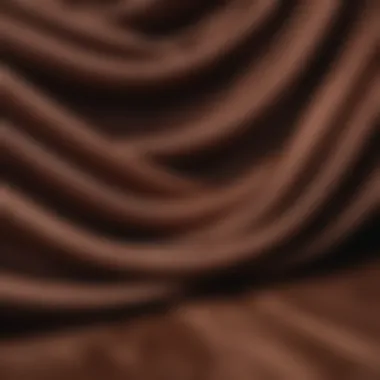
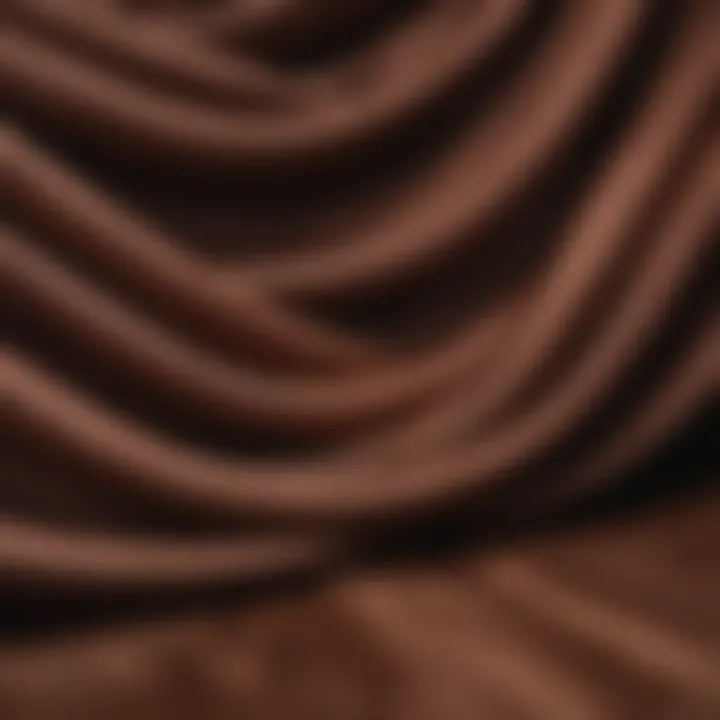
When to Seek Professional Help
Removing chocolate stains can sometimes be a straightforward task, especially when addressed promptly. However, there are instances when the situation demands a professional's intervention. Knowing when to seek help is crucial, as it can save clothing from further damage and ensure the best results.
Identifying Stubborn Stains
A stubborn chocolate stain does not respond to standard cleaning methods. Factors that contribute to the persistence of the stain include the type of fabric, how long the stain has been set, and the cleaning agents used. For example, delicate fabrics like silk can absorb chocolate oils deeply, making it difficult to fully eradicate the mark. If repeated cleaning attempts leave a residue or discoloration, it may be time to consult an expert. Recognizing a stain as stubborn could save you time and potentially avoid ruining the garment.
Consulting a Dry Cleaner
Visiting a dry cleaner offers several advantages for treating chocolate stains. Professional cleaners have access to specialized equipment and cleaning solvents that can penetrate stubborn stains more effectively than household remedies. Additionally, they are trained to assess fabrics and stains, ensuring the right method is applied for each case. This can prevent fabric damage, especially for items that carry sentimental value or are quite expensive.
"When in doubt, seeking expert assistance can save not only a beloved piece of clothing but also reduce anxiety over potential damage."
Before taking your garment to a dry cleaner, it's wise to communicate details about the stain and the type of fabric. This allows them to tailor their approach, maximizing the chances of fully removing the stain. Overall, if the chocolate stain is significant or resistant, considering professional help could be both a savvy and practical choice.
Common Misconceptions about Stain Removal
Understanding misconceptions about stain removal is crucial for effectively tackling chocolate stains. Many homeowners believe in certain myths that may not be true, leading to ineffective cleaning strategies. These misconceptions can be detrimental, as they might result in permanent damage to fabrics or make stains more difficult to remove. Addressing these myths not only improves the cleaning process but also increases the confidence of individuals in managing their laundry.
Myths about Hot Water
A common belief is that using hot water will efficiently remove chocolate stains from clothing. The reality is that hot water can set the stain, especially if the chocolate has already been absorbed by the fabric. Heat causes proteins in the chocolate to bond firmly with the fabric fibers, making them significantly more difficult to remove. Thus, when confronted with a chocolate stain, cold water is preferred as the initial rinse. This helps in loosening the chocolate particles without sealing them into the fabric. The consensus among fabric care experts is clear: avoid hot water at all costs when dealing with stains, particularly chocolate.
The Role of Vinegar
Another popular myth is the effectiveness of vinegar as a universal stain remover, including for chocolate stains. While vinegar can be beneficial for various cleaning purposes, its effectiveness on chocolate is overstated. When vinegar is applied directly to a chocolate stain, it may not have the desired impact and can sometimes cause discoloration, especially on delicate fabrics. The acidity in vinegar might react with other elements in the chocolate. Instead, using mild detergents specifically designed for stain removal is often more practical. It's important to test any cleaning agent, including vinegar, on a small, inconspicuous area before widespread application.
"Understanding the facts about stain removal can save your favorite garments from irreversible damage."
By dispelling these misconceptions, individuals can approach the task of stain removal with a clear mindset and effective strategies. Accurate knowledge about cleaning methods enhances the overall stain removal experience, ensuring that favorite clothing items remain in pristine condition.
Preventing Future Chocolate Stains
Preventing chocolate stains is an important aspect of maintaining the integrity and appearance of clothing. While many techniques exist for removing stains once they have occurred, addressing the issue proactively can save time and effort. By understanding the elements involved in preventing stains, one can make informed choices during activities that involve chocolate.
A significant consideration is the type of fabric being worn. Some materials attract stains more easily than others, which makes the choice of clothing essential. The benefits of this preventative approach extend beyond mere stain removal; it protects the investment in your wardrobe and enhances overall confidence while enjoying chocolate-related treats.
Choosing Appropriate Fabrics
Selecting fabrics that resist stains is a key strategy in preventing chocolate mishaps. Natural fibers such as cotton and linen are more susceptible to staining, while synthetic materials often provide improved resistance. When dressing for occasions that involve chocolate, consider materials like polyester or blends that incorporate stain-resistant properties.
- Avoid sensitive fabrics: Materials like silk or velour should be reserved for occasions where chocolate exposure is minimal.
- Opt for treated fabrics: Stain-repellent finishes are available on many garments. Look for water and stain-resistant labels when shopping.
Implementation of these choices requires attention during shopping or wardrobe decisions. Understanding which fabrics offer better resistance can aid in making effective selections.
Best Practices While Eating Chocolate
How one interacts with chocolate plays a crucial role in stain prevention. Engaging in mindful eating can greatly reduce the chances of staining clothing. Here are some practical steps to take:
- Use napkins or plates: Always serve chocolate treats on a plate instead of handling them directly, minimizing contact with clothing.
- Be conscious of movement: Avoid eating chocolate when wearing light colors or during activities where messy exposure is likely, such as while walking or talking.
- Educate others: When hosting gatherings, inform guests about using napkins as a precaution against chocolate spills.
Epilogue
In this article, the conclusion serves as a crucial element, wrapping up the extensive discussion on how to effectively remove chocolate stains from clothing. The methods discussed not only highlight practical steps but also underscore the importance of understanding the nature of chocolate stains. With the appropriate techniques, one can address stains promptly and effectively, potentially saving favorite garments from permanent damage.
Key considerations include acting swiftly when a stain occurs. The sooner you treat a chocolate stain, the easier it is to remove. Utilizing the right methods tailored to specific fabric types further enhances effectiveness. For instance, the cleaning process for cotton differs significantly from that of silk, and being aware of these differences is essential.
Another point of significance is recognizing when to seek professional help. As discussed, some stains may resist home remedies. Identifying stubborn stains paves the way to making informed decisions about when to consult a dry cleaner.
Overall, understanding these techniques provides not only the confidence to tackle stains but also the knowledge to prevent future occurrences. This proactive approach can lead to better garment care over time.
Summary of Key Points
- Chocolate stains require prompt attention to ensure effective removal.
- Different fabrics necessitate different cleaning techniques; awareness here is key.
- Recognizing when to seek professional help can save time and prevent frustration.
- Proper aftercare can enhance the longevity of treated garments.
Encouragement for Practical Application
The techniques outlined in this article serve as a valuable resource for homeowners and design enthusiasts. Practical application of these methods can lead to a significant reduction in the frequency of permanent stains on cherished clothing. Attempting these techniques not only reinforces knowledge but also fosters a sense of achievement in garment care.
Most importantly, don't hesitate to put theory into practice. Each successful removal of a stain allows you to refine your method and develop an intuition for fabric care. With diligence and awareness, chocolate stains can become a minor inconvenience rather than a distressing problem. So go ahead—apply these strategies next time you face a chocolate mishap, and enjoy the satisfaction of restoring your clothing.















